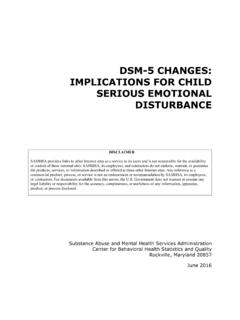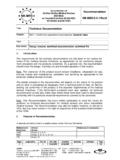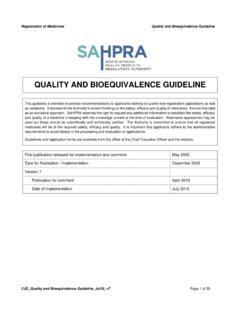Transcription of Guidelines on Good Labelling Practice for Pesticides
1 Guidelines on good Labelling Practice for Pesticides Food and Agriculture Organization of the United Nations Guidelines on good Labelling Practice for Pesticides Food and Agriculture Organization of the United Nations Rome, 1995 iTABLE OF CONTENTS Guidelines on good Labelling Practice for Pesticides Page SECTION I: INTRODUCTION About These Guidelines 1 What is a Label ? 1 The Importance of Clear and Accurate Labels 1 General Considerations 2 SECTION 2: LABEL CONTENT What is in the Container ? 5 Safety Information 5 Instructions for Use 6 Other Information 7 SECTION 3: HOW TO WRITE A LABEL Layout of Information 9 General Points 9 Label Layout 10 Labels for Small Packs/Supplementary Leaflets 12 Label for Pre-Measured Packs and Twin/Multi-Packs 13 Dual/Multi-Language Labels 13 Style and Wording of Text 13 Print Size and Style 13 Effective Use of Space 14 Layout Design and Artwork 15 Use of Colour 15 Use of Illustrations / Pictograms 16 Pictograms 16 Illustrations 17 Page ii Special Purpose Labels 17 Bulk Material Labelling 17 Chemically Treated Seeds 18 Application by Air 18
2 Application in Confined Spaces 19 How to Check a Label 19 SECTION 4: TOXICITY AND HAZARD classification Definitions 21 Hazard classification 21 Calculation of LD50 Values for Formulations where Data are not available 23 Inhalation Toxicity 24 Product / User Categories 24 Determining Hazard Symbols and Statements 25 Use of Positive Statements on Labels 26 TABLES Table 1: Determination of WHO Hazard classification based on acute LD50 (rat) of formulated product (mg/kg) (6). 22 APPENDICES Examples of Labels 27 Print Size and Style Guide 33 Safety Statements 34 Safety Statements 34 First Aid Instructions and Advice to Doctors 35 iii Page Agricultural Practice 37 Withholding Period Statements 37 Statements and Phrases for good Agricultural Practice 37 Care, Use and Disposal of Containers and Baits 38 Care of Equipment.
3 Area to be Treated and Occupants 38 of Treated Areas Physical properties 39 International Formulation Coding System 43 Label Content 45 Summary of Recommended Label Content 46 Flow Chart for Checking the Draft Label 48 Check List for Reviewing Label Content 49 References 51 iv SECTION 1: INTRODUCTION About these Guidelines FAO published " Guidelines on good Labelling Practice for Pesticides " in 1985 (1). Those Guidelines gave guidance on the preparation of a label and specific advice on content and layout. Since that time there have been considerable changes in regulations and requirements.
4 There is, therefore, the need to revise and update the Guidelines . These Guidelines are intended for use by those in industry involved with label preparation and also by national regulatory personnel involved with the approval of labels and the specification or recommendation of suitable text and layout. The document contains four main sections with appendices. The first section identifies the main objectives and considerations in preparing a label. The second section identifies the information which must appear on a label. The third section deals with writing a label with maximum clarity and consideration of the level of knowledge of users. The fourth section discusses the establishment of toxicity and hazard classifications for a product. The appendices contain examples of labels, hazard statements, agricultural Practice statements and other summaries of specific and generic label contents which can help to clarify the general text.
5 What is a label ? A label is the written, printed or graphic material firmly attached to a product container. It is the outcome of years of research on the part of industry and evaluation effort on the part of government regulatory agencies. The label is a mandatory part of the product package. Additional information may be provided by means of technical leaflets or brochures which accompany a container, in which cases these leaflets or brochures should be referred to on the label. The importance of clear and accurate labels Labels are the principal, and sometimes the only, contact between the manufacturer/supplier and the user of the product. Labels are legal documents and convey essential safety information and use recommendations. The appeal to the user to "read the label" can only be successful if the essential messages on the label are kept as simple and direct as possible.
6 If a label is too complex, too technical, or badly laid out, the product may not be used correctly and the user may be exposed to unnecessary health risks. There is, therefore, a great need for clear directions which can be easily understood by all potential users. The basic regulations affecting label content are national regulatory requirements. In addition to these, there are additional standards within individual companies and international standards, the most important of which is the FAO International Code of Conduct on the Distribution and Use of Pesticides (2). Labels should conform to all of these regulations and standards. General considerations Most Pesticides are manufactured to be sold in several different countries. As a result, accurate translation of product labels into many languages is necessary.
7 In some cases, there may even be a need to have two or more languages on the same label. However, despite the number of language translations on a label, there still remain some users who are unable to read a label. For these users, pictograms which depict safe use and use of protective clothing during application are essential. Even when pictograms are used, however, care must be taken that they are properly understood by the user. The increased demand for more information on how to use Pesticides correctly, and the need for dual languages, hazard symbols and pictograms on labels creates serious competition for space in label design. The four principal ideals to adhere to in preparing a label are clarity, completeness, conformity and consistency. Clarity is achieved by avoiding complex or excessively technical explanations and by using a clear layout with a prominent display of key words, phrases and symbols, and pictograms.
8 Thus it is important to: - attract the user's attention; - tell the user what he needs to know in brief and precise terms; - use familiar expressions and symbols; and, - avoid ambiguous statements. Completeness is ensured by using a checklist of all essential information, so that no important information or advice is omitted. Conformity is achieved by following existing regulations and Guidelines , both national and regional/multinational. Consistency is assured by the standardization of label components, such as safety texts, so that label texts and layout of different labels will be as similar as regulatory requirements and user needs allow. There may sometimes be a conflict in the wording required by regulatory authorities on the one hand and the clear instruction to the farmer on the other.
9 Regulatory authorities, however, are frequently open to accepting easier to read statements, especially if they are consulted during the preparation of a label. Leaflets and brochures are not subject to the same regulatory rules as labels. Nevertheless, the same principles of writing technical data in a simple and easily understood manner apply to leaflets and brochures used for advertising, just as they do for labels. In addition, whether it is a label or leaflets and brochures which provide technical information, it is essential that the information provided is accurate and can be substantiated with technical data. 3 The writer of the label also has responsibility 1. To the user - who must be able to read and understand the label; 2. To the public and the environment - to protect both public health and the environment; and, 3.
10 To the law - to follow pertinent regulations. Lastly, labels should have physical durability. They should be resistant to the normal wear and tear encountered in transport, storage and use. These requirements apply equally to the print on the label and the material on which the information is printed. Several years of storage may elapse between manufacture and final use of the product. Without a complete and legible label during storage and at the time of final use, a pesticide is likely to present a serious potential hazard. 4 5 SECTION 2: LABEL CONTENT The purpose of the label is to provide the user with all the essential information about the product and how to use it safely and effectively. The content of a label is subject to national regulations. At times, there may be additional multinational or regional considerations.

















